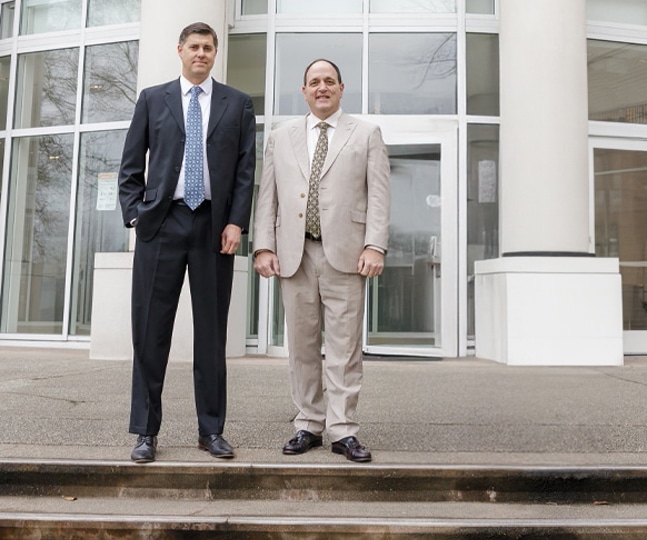Free Case Evaluation

Seattle Brachial Plexus Injury Lawyers
Strong advocacy for Washington newborns and parents when birth injuries occur
Every parent has the right to anticipate that when they leave the hospital, their newborn will be healthy and live a full life. Doctors should anticipate the problems likely to occur during any delivery. One of the common problems that obstetricians need to anticipate is damage to a baby’s shoulder, which can cause brachial plexus injuries. Brachial plexus injuries can cause your newborn to lose the use of his/her hand or arm. At Smith McBroom, we work with a network of physicians who understand why birth injuries occur and when the birth delivery team and hospital should be held accountable. Our Seattle brachial plexus injury lawyers help hold doctors and others accountable for your newborn’s medical bills, pain and suffering, and loss of quality of life. Call us for help today.

How can we help?
- What are brachial plexus injuries?
- What are the signs my child has a brachial plexus injury?
- Why do brachial plexus injuries happen?
- Who is liable for brachial plexus injuries in Seattle?
- How is a brachial plexus injury diagnosed?
- Are there treatments for brachial plexus injuries?
- Do you have a Seattle brachial plexus injury lawyer near me?
Free Case Evaluation
What are brachial plexus injuries?
The prestigious Johns Hopkins University states, “The brachial plexus is a bundle of nerves that stems from nerve roots in the cervical (neck) and upper trunk (torso) sections of the spinal cord (C5-T1), creating a network that connects to the nerves in the arm.” The brachial plexus nerves control the use of your child’s arms, wrists, and hands. These nerves also include the ability to experience pain.
There are five brachial plexus nerve branches:
- Musculocutaneous nerves. These nerves help the muscles in the upper arm, shoulder, and elbow.
- Axillary nerves. These nerves help the shoulder rotate and help your child lift his/her arm away from their body.
- Median nerves. These nerves enable the forearm and parts of the hand to move.
- Radial nerves. These brachial plexus nerves control muscles in the upper arm, forearm, elbow, and hand.
- Ulnar nerves. These nerves help the fingers exercise fine motor control.
Brachial plexus injuries prevent the spinal cord and the arm, wrist, and hand from communicating. The injuries can cause the inability of your child to use their arm or hand and the inability to experience sensation in those body parts.
The severity of a brachial plexus birth injury depends on the nerve that is damaged and the extent of the damage. Some children can regain full function while other newborns live with permanent disabilities.
Brachial plexus nerve injuries are categorized as stretching injuries, a brachial plexus rupture, brachial plexus neuroma (scarring), brachial neuritis, and brachial avulsion (the nerve is completely separated from the spinal cord). A brachial avulsion is generally considered the most severe type of brachial plexus birth injury.
What are the signs my child has a brachial plexus injury?
Johns Hopkins states that the symptoms of brachial plexus vary depending on the location of the damage. The shoulder is likely to be affected if the nerve injuries are higher up on the spinal cord or in the neck. Lower nerve injuries generally affect the hand, wrist, and arm.
Some symptoms your newborn may experience include:
- A limply hanging arm
- Loss of sensation in the arm or hand
- Inability to control the hand, wrist, arm, or shoulder
- Sudden pain or a burning or stinging sensation in the arm or shoulder
Why do brachial plexus injuries happen?
A brachial plexus birth injury is also called an obstetric brachial plexus injury. Birth delivery doctors and hospitals should anticipate that a brachial plexus injury may occur at birth. Brachial plexus injuries occur in 1 to 2 births per 1,000. Risk factors include large babies, difficult and long vaginal deliveries, and mothers with diabetes. Another risk factor involves breech deliveries (the bottom end comes out first).
The brachial plexus nerves can be damaged if the head of your newborn stretches away from the shoulder.
A brachial plexus injury known as shoulder dystocia can occur, per Johns Hopkins, “when the shoulder is temporarily stuck under the pubis during delivery.”
Brachial plexus birth injuries usually take one of these forms:
- Erb’s palsy. This birth injury causes “numbness and loss of motion around the shoulder and an inability to flex the elbow, lift an arm, or bring objects to the mouth.”
- Klumpke’s palsy. This less common birth injury “affects the lower brachial plexus, leading to loss of motion and/or sensation in the wrist and hand, such as being unable to move fingers.”
Who is liable for brachial plexus injuries in Seattle?
At Smith McBroom, we work with experienced obstetricians and brachial plexus injury specialists to show what steps your physicians failed to take to protect your child, what medical care your child will need for his/her birth injuries, and all the challenges and pain your child will face due to the birth delivery team’s medical malpractice.
Our Seattle brachial plexus injury lawyers file medical malpractice claims against all responsible healthcare providers. The defendants in your child’s case may include:
- The delivery doctor/obstetrician
- The hospital where the delivery occurred
- An anesthesiologist
- The medical team, including nurses and medical technicians
- A midwife
Our personal injury lawyers demand compensation for all your child’s current and future:
- Medical expenses
- Loss of use of the body part affected
- Loss of life’s pleasure
- Physical pain and emotional suffering
- Wages lost while taking care of your child
How is a brachial plexus injury diagnosed?
At Smith McBroom, we’ll arrange to have a brachial plexus specialist examine your child. The physician will conduct a physical exam to determine your child’s ability to use his/her arm, wrist, and hand and to experience sensations in those body parts.
Imaging tests will often include:
- X-rays of the shoulder and neck to identify any bone fractures, bone damage, and dense tissue around the brachial plexus nerves.
- MRIs and CT scans use contrast dyes to help confirm the brachial plexus injuries.
- Other diagnostic tests that use electrodes to examine the nerves include an electromyogram and a nerve conduction study.
These tests will likely be repeated every few months or weeks so your child’s physician can determine what progress is being made.
Are there treatments for brachial plexus injuries?
The treatments vary depending on the location and severity of the brachial plexus injury. Some babies recover without treatment over weeks or months. Generally, pediatric neurologists and/or neurosurgeons will examine your child if your child doesn’t improve after three months of occupational therapy. About 10% of babies with brachial plexus injuries require some type of surgery.
Johns Hopkins recommends that brachial plexus surgery, if required, be conducted within four to nine months from birth.
Nonsurgical interventions include physical therapy (range of motion and flexibility exercises), corticosteroid creams and injections, assistive devices (such as braces and splints), medications, and occupational therapy (helping your child with daily activities). The interventions are likely to change as your child ages.
Surgical interventions include repairing torn nerves, neurolysis (removing scar tissue), nerve grafts (using a healthy nerve “from another part of the body to connect two ends of a separated nerve”), nerve transfers (“attaching a less important but still functional nerve to the damaged nerve creating a framework for new growth”) and tendon and muscle transfers.
Nerves take a long time to heal, which means it may take months or longer to know how well the surgery helped your child.
Without surgery, your child may lose the permanent use of his/her arm or hand. Johns Hopkins states:
Some brachial plexus injuries can result in Horner’s syndrome, a disorder in which certain nerves of the sympathetic nervous system are damaged. This syndrome can lead to a drooping eyelid, overly constricted pupil, and decreased facial sweating on one side of the face. There is no specific treatment for Horner’s syndrome, but sometimes treating its underlying cause may help to alleviate symptoms.
Brachial plexus injuries that are too severe or aren’t treated promptly can cause chronic pain.
Do you have a Seattle brachial plexus injury lawyer near me?
At Smith McBroom, we meet parents and children at our Seattle office at 16400 Southcenter Parkway Suite 210. If your child is very ill, we’ll meet you at a more convenient location. Our attorneys also talk with clients by phone and through video conferences.
We understand how concerned and scared you are for your child’s future. We’ll calmly and clearly answer your questions, ensure your child sees the doctors who can best help him/her, and fight for all the compensation you deserve.
Contact our Seattle brachial plexus injury lawyers now
You want your child to live the best life possible. When a child has a brachial plexus injury, living their best life means holding the doctors and hospitals who made medical mistakes during the delivery accountable. At Smith McBroom, our birth injury lawyers have the experience and network of medical relationships to show what mistakes occurred during the delivery of your child. We demand compensation so there are the funds for the medical care your child needs and the compensation for the personal suffering damages he/she deserves. Please call us or complete our contact form to schedule a free consultation. We’re ready to secure your child’s future. We represent sexual abuse victims in Tukwila, Seattle, and across Washington state.
